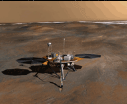
Mars Introduction:
Mars – The fourth planet of the eight planets of the solar system, between the Earth and the asteroids, is about 1.52 AU from the Sun, the size is only 1/6 of the Earth, and the weight is 1/10 of the Earth. The farthest distance from the sun. The ancient Martian is also known as the illusion, and the meaning of English Mars is the meaning of God of War.
Martian terrain
From the previous observations of Mars, the most impressive thing is that the white polar regions of the Martian poles and the red surface can be seen directly from the medium telescope, which means that the atmosphere of Mars is not thick, not covered like Venus. The entire surface. The distance of Mars from the Earth, second only to Venus, has become a good research subject. Using the Hubble telescope to make observations, you can take images of the surface of Mars.
In the photograph of Mars taken by the exploration ship, you can see that the surface of Mars has traces like a canal. The photo on the left is the area of the mid-latitude of Mars. The surface of the surface can be clearly seen. So in the early research, At one time, Mars was facing an unprecedented period of drought, so the intelligent creatures of Martians constructed a network of water-transporting nets on the surface, transporting water from the polar regions to low-latitude areas, but this claim has been overthrown. Photo data shows that these “canals” of Mars may not have water at all. So far (2001), no high life activities on Mars have been found.

The surface of Mars is extremely varied. The northern hemisphere has a young low-lying plain with a total surface area of 30%. The southern hemisphere is an ancient highland with craters. It is an asymmetrical structure with a low north and a high south. At the north and south poles of Mars, there are water ice and dry ice. A huge crown that has been piled up. Most of the polar caps on the surface of Mars are made up of dry ice. In summer, the dry ice of the polar crest is retracted, while in the winter, the crest is expanded. The surface is also Olympus and Large-scale terrain structure such as the Sailor Canyon.
Mount Olympus is the largest volcano on the surface of Mars, up to 27 kilometers, more than twice as high as the highest peak on the earth. The mountains stretch for 600 kilometers, about 1.5 times longer than Taiwan. The large canyon is long. More than 4,000 kilometers, accounting for one-fifth of the circumference of Mars. It is very significant large terrain.
Mars surface environment
Due to the influence of science fiction and film plots, humans have always believed that Mars is the second planet that humans can master, and on Mars, there may be Martians.
In some ways, this may be true, because the surface environment of Mars is the closest to the Earth among the nine planets. Although the size of Mars is not commensurate with the Earth, Mars is biased at the axis of rotation (25.19 degrees, with the Earth’s 23.44 The degree is similar), the rotation speed (1.026 Earth days), and the surface temperature (-140 to 20 degrees, close to the Earth’s -50 to 50) are very similar to the Earth. Therefore, there are also four seasons similar to Earth on Mars. The time of day is similar to that of the earth. You don’t need to change your living habits, and the temperature looks more pleasant than Venus and Mercury. People are full of interest and expectation for future research on Mars.
For these reasons, NASA’s scheduled Mars observation program will launch two probe ships every two years for the detection of Mars. The other reason is to launch the Mars exploration ship every two years because Mars every two. The year will approach the Earth once, and the Mars exploration ship can reach Mars in the shortest time.

Mars Introduction
Pictured above is a 360-degree photograph of the Martian environment taken after the US Pathfinder program arrived on Mars on July 4, 1997. The lower part is the Mars base of Pathfinder, and the two peaks are in front of each other. It can be seen that the surface of Mars is covered by brown sand, and many stones are scattered on the earth’s surface. The photograph of Mars has a characteristic that it looks like the ground plane is very close. This is because of the small relationship between Mars and the curvature. , so the ground plane quickly disappeared in front of the eyes, producing such an effect.
Astral structure
It is speculated that there is a core with iron as the main component in the center of Mars, and it contains light elements such as sulfur and magnesium. The proportion of the core of Mars should be smaller than that of the Earth. The outer layer of the core is thickly covered with a layer rich. The bismuth salt of magnesium oxide has a rocky crust on its surface. The density of Mars is the lowest of terrestrial planets, only 3.93 g/cc.
Atmospheric structure
Mars has a thin atmosphere, about 95% is carbon dioxide, 3% is nitrogen. Like Venus, it is mainly carbon dioxide, but the thickness is much different, so the surface is still cold. The water vapor is only 0.03%, very dry. The average temperature on the surface of Mars is very low, even below the equator, it is minus 50 degrees Celsius, and the temperature of Mars will be above 0 degrees in very little time.
In the long-term monitoring of the surface of Mars, US satellites have found that large-scale sandstorms often occur on the surface of Mars, covering even the world.
satellite
Mars has two flat, rounded satellites, Forbes and Dimos. The shapes are not round.
The inside of the Phobos is a 27X21X19km rugby-shaped volleyball that revolves around an 8-hour cycle. The picture on the left is a photo of the Viking 1 probe ship, and you can see the large left upper left. Potholes, 10 km, about 1/2 of its diameter
The outer satellite, Deimos, is a 15X12X11 km ellipsoid that revolves around a ten-hour period. The two satellites have the same direction of rotation as Mars. The picture on the left is a photo from the Viking 1 probe ship.

Mars Introduction
Mars observations
The apparent diameter of Mars varies greatly, from 3.5 seconds to 25.7 seconds. Therefore, a small telescope can only observe the polar crown and dark areas of Mars near the rush every two years. Mars Stars up to -2.8, etc., present a bright orange-red color, a small orange point in binoculars. With the naked eye, you can see a bright red star that is not easy to flash.
Mars’ revolution period is 687 days, about two years, so the occurrence of Mars’s rush (close to the Earth) will occur only once every two years. This is why NASA only launches two probe ships to Mars every two years. .
Mars’s detection plan
NASA’s future plans for Mars exploration are still very active. The Mars exploration vessels expected to be launched in 2007-2009 are as follows:
1. 2007 Phoenix Ship (PHOENIX):
The Phoenix will be launched in August 2007 and is expected to arrive on Mars on May 25, 2008. Scientists continue to probe the structure of ice and water on the surface of Mars. The launching ship will land directly on the Arctic in Mars. Mars’s ice cap and soil for in-depth research. The picture on the right shows the imaginary map of the Phoenix spacecraft landing.

Image source: NASA
Related Links: NASA Website http://mars.jpl.nasa.gov/missions/future/phoenix.html (English) Phoenix
2. Mars Science Laboratory in 2009: After successfully launching two landing probe ships in 2004, NASA is expected to launch the Science Laboratory Spacecraft in the fall of 2009 and arrive in Mars in October 2010. Will continue to collect soil on the surface of Mars to analyze the organic chemical composition of the surface of Mars, which is believed to bring valuable knowledge of the organic matter on the surface of Mars. The picture on the right shows the imaginary map of the Mars Science Laboratory.

Image source: NASA
Related links: NASA page http://mars.jpl.nasa.gov/missions/future/msl.html (English)
The Mars Science Laboratory, a mission with instruments from Russia, Spain, and Canada as well as the United States, explores a canyon plateau in this artist’s conception.
High-definition pictures (click on the picture to see the original picture):




